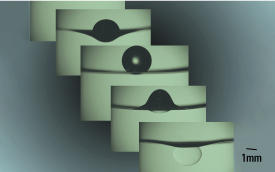

07/27/2020

© 2020 Thomas Russell
A way to suspend droplets of a denser fluid from the surface of a less dense fluid has been found by an international team led by an AIMR researcher1. This unusual effect could find application in microreactors and microrobots.
If you drop a liquid such as water into a less dense, immiscible liquid such as oil, it will sink to the bottom of the container. But a team led by Thomas Russell of the AIMR at Tohoku University noticed something curious while they were investigating the printing of three-dimensional water structures in water in a previous study—they found that some water droplets containing a polycation and dextran (a polysaccharide made up of many glucose molecules) hung from the surface of aqueous solutions of the polymer poly(ethylene glycol) (PEG) with a polyanion.
What made it more puzzling was the fact that the two solutions have an extremely low interfacial tension—the attractive force between molecules across the interface of two fluids. Some insects exploit the high interfacial energy between their highly water repellent legs and water to walk on water, but the interfacial energy is very low in the case of dextran and PEG.
“This effect was unexpected,” says Russell. “It was very curious how the heavier droplet could hang on the liquid surface with such a low interfacial tension.”
With their curiosity piqued, Russell and his co-workers looked deeper into the effect. They discovered that a polyelectrolyte complex formed at the interface between two aqueous solutions and that this allowed the heavier dextran droplets to hang from the PEG surface.
“The condition for hanging the dextran droplet from the interface between air and PEG is determined solely by the force balance between gravitational stresses and surface stresses on the PEG side of the droplet,” explains Russell. “Remarkably, nothing else matters.”
The droplets are highly versatile, making them promising for use in microrobots and microreactors. “By embedding magnetic microparticles in the hanging droplets, we could get them to move and rotate under the influence of an applied magnetic field,” says Russell. “Also, we found a hanging droplet with an opening to air could, like a mosquito larva, use air to perform some reactions and induce a cascade reaction in a neighboring droplet.”
The team is now creating a bioinspired meniscus-climbing system, which can transport and shuttle materials from the land to the solution on the liquid surface. They also have plans to use the system to create an artificial cell that can fix carbon dioxide.
This research highlight has been approved by the authors of the original article and all information and data contained within has been provided by said authors.